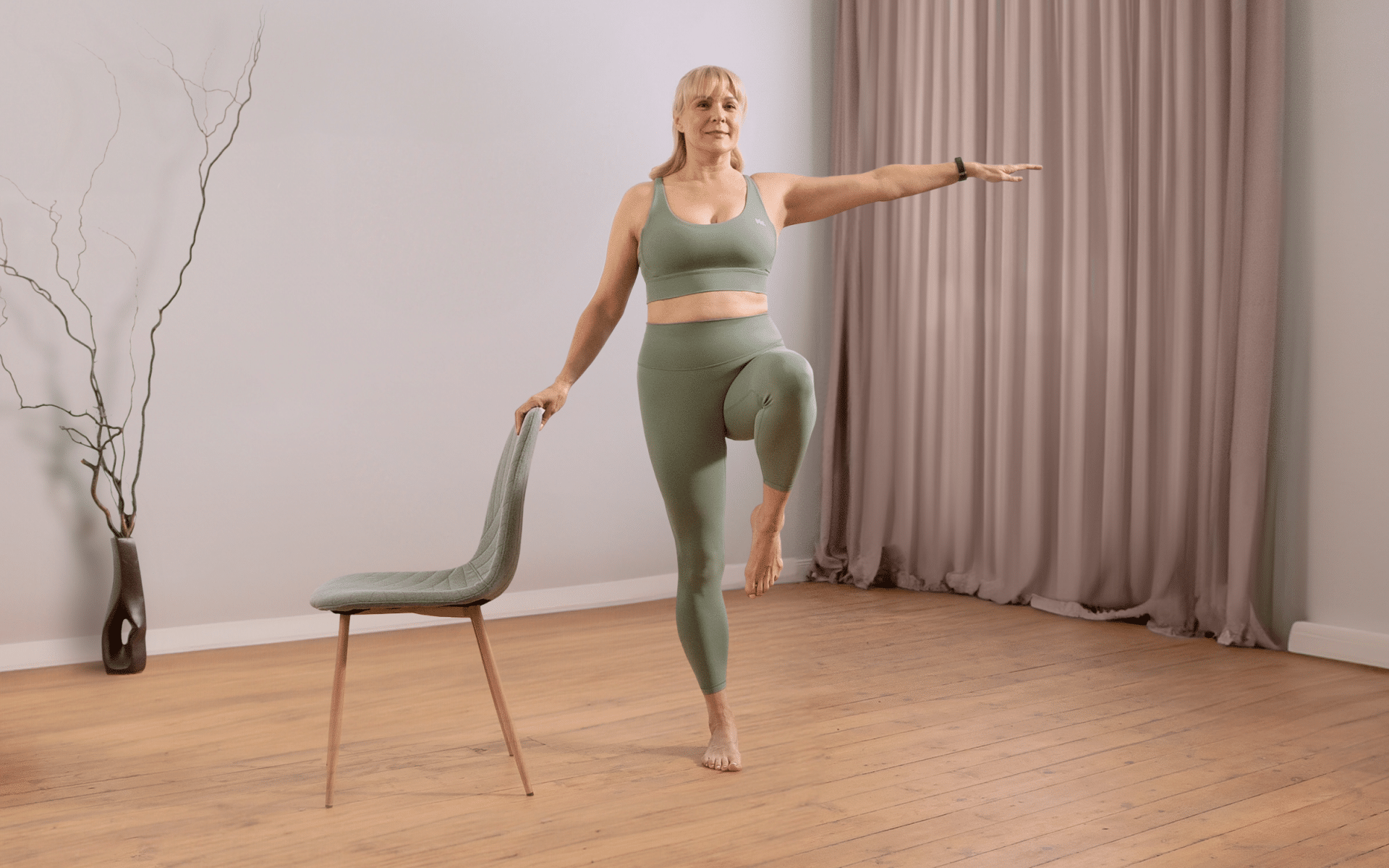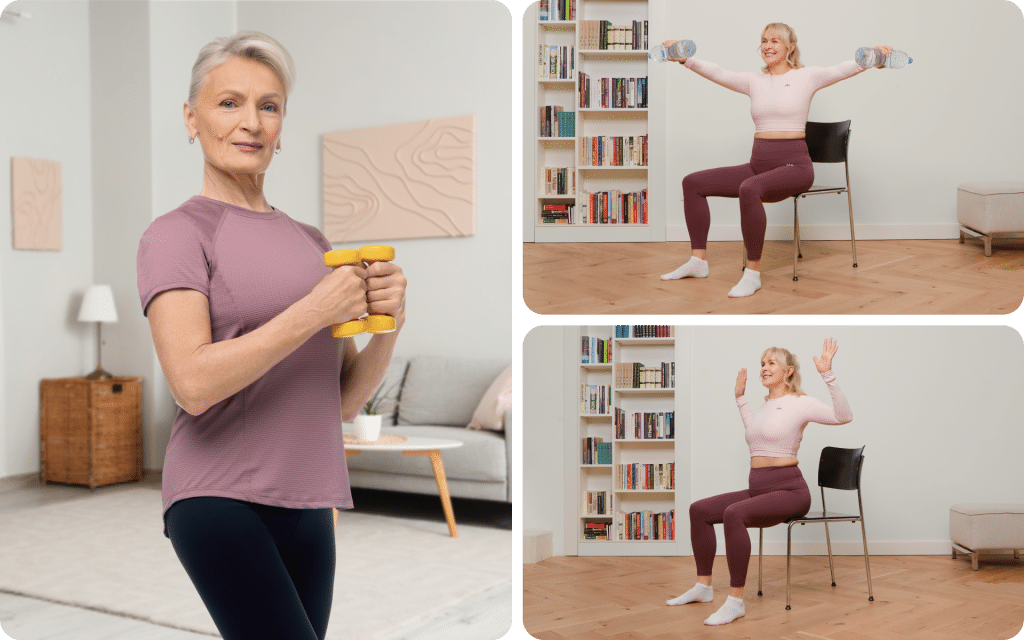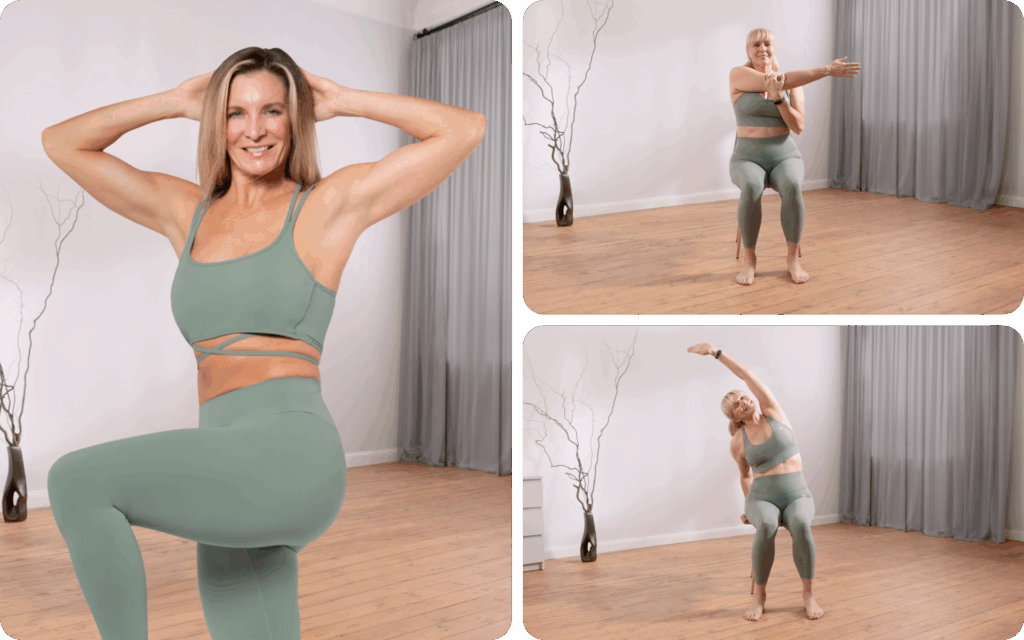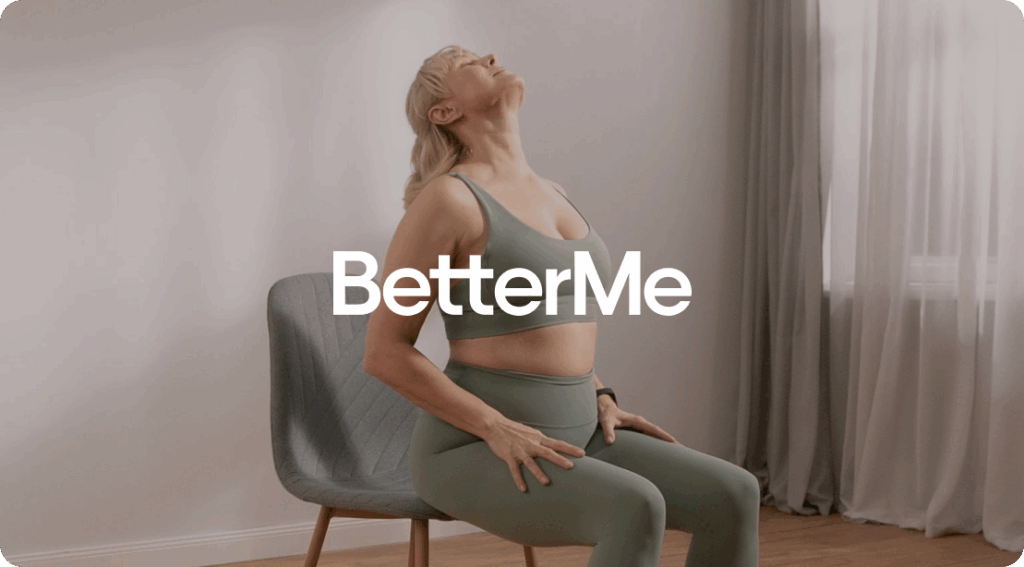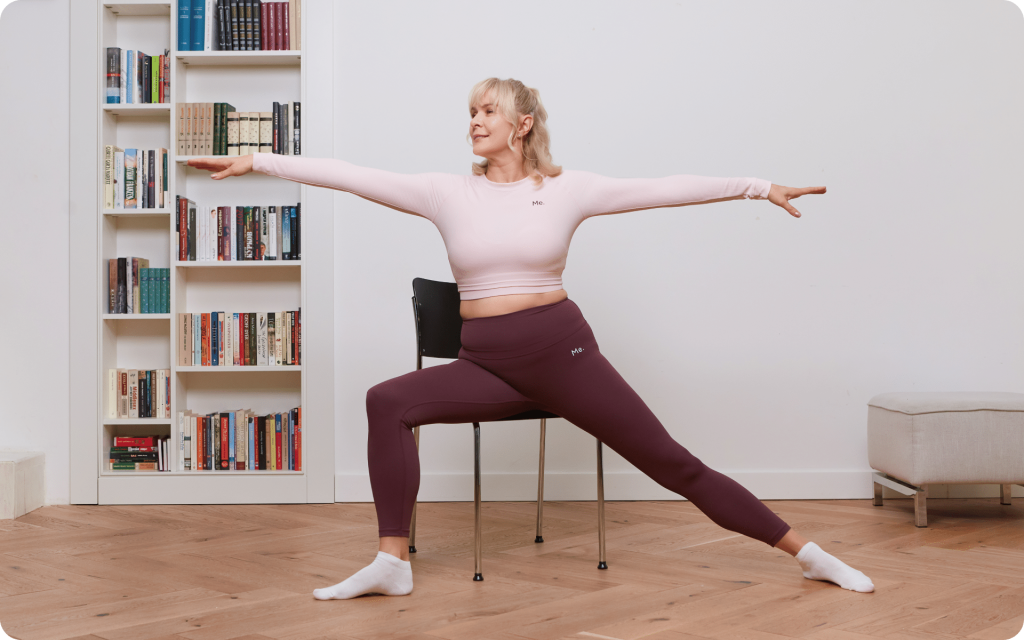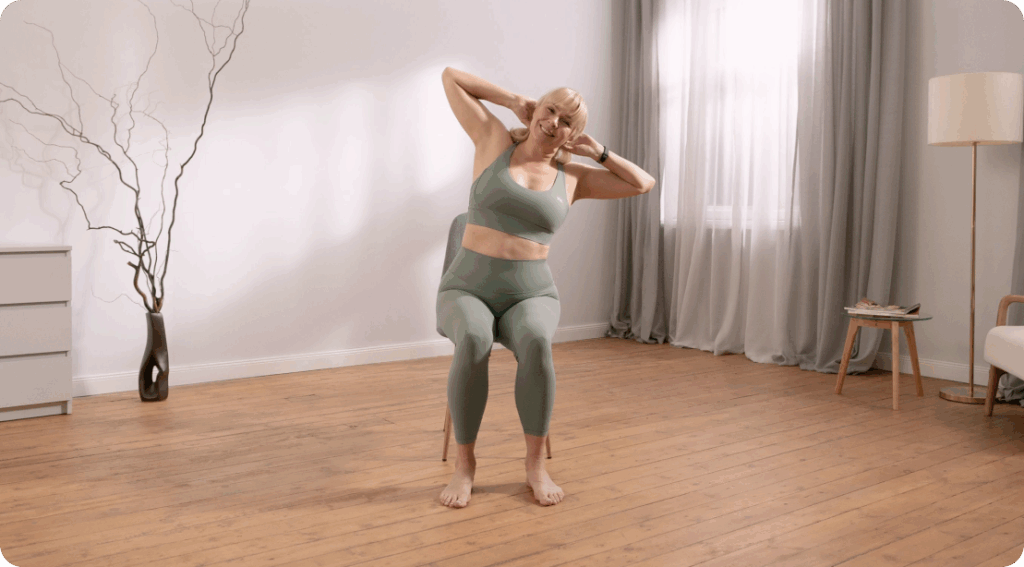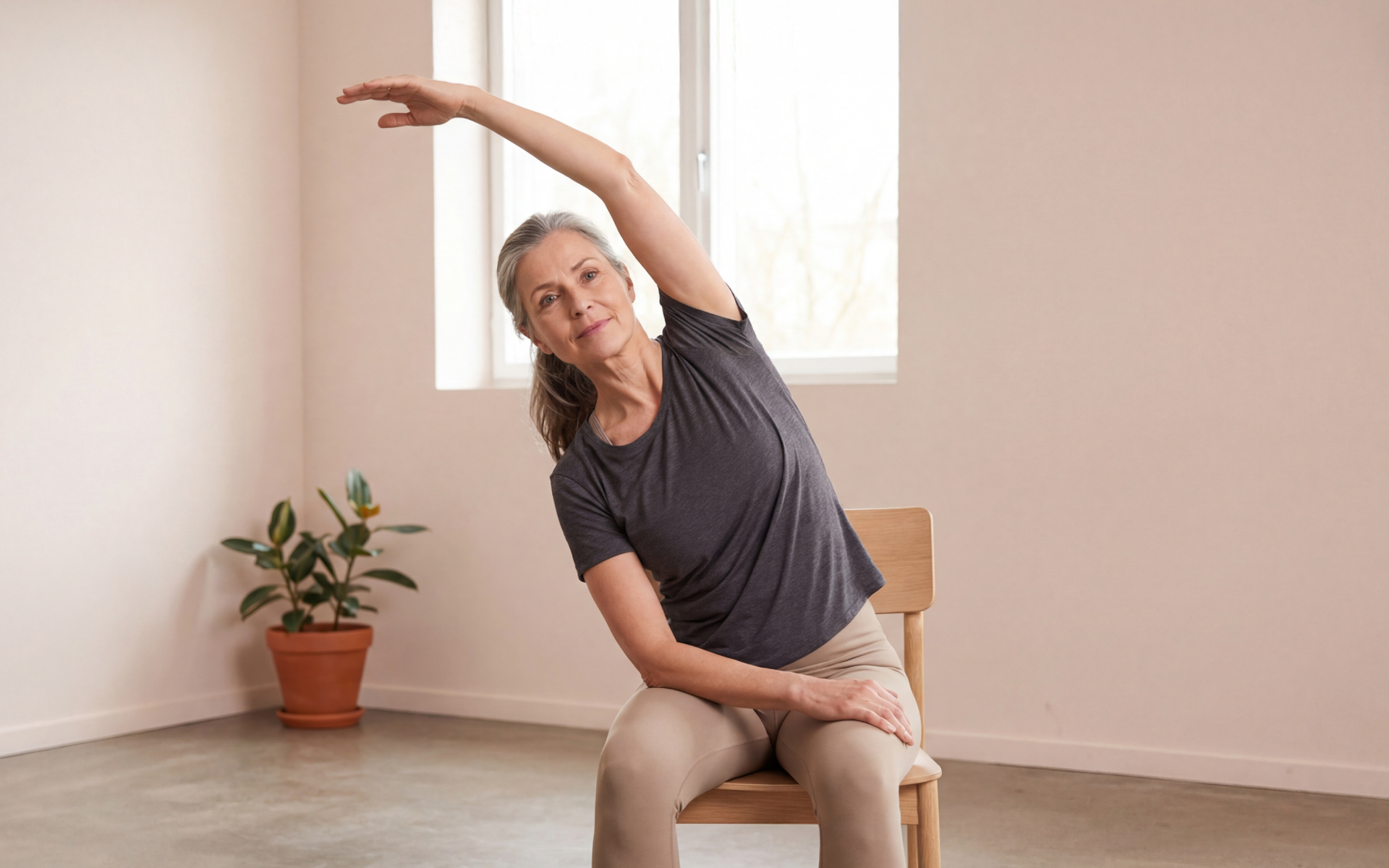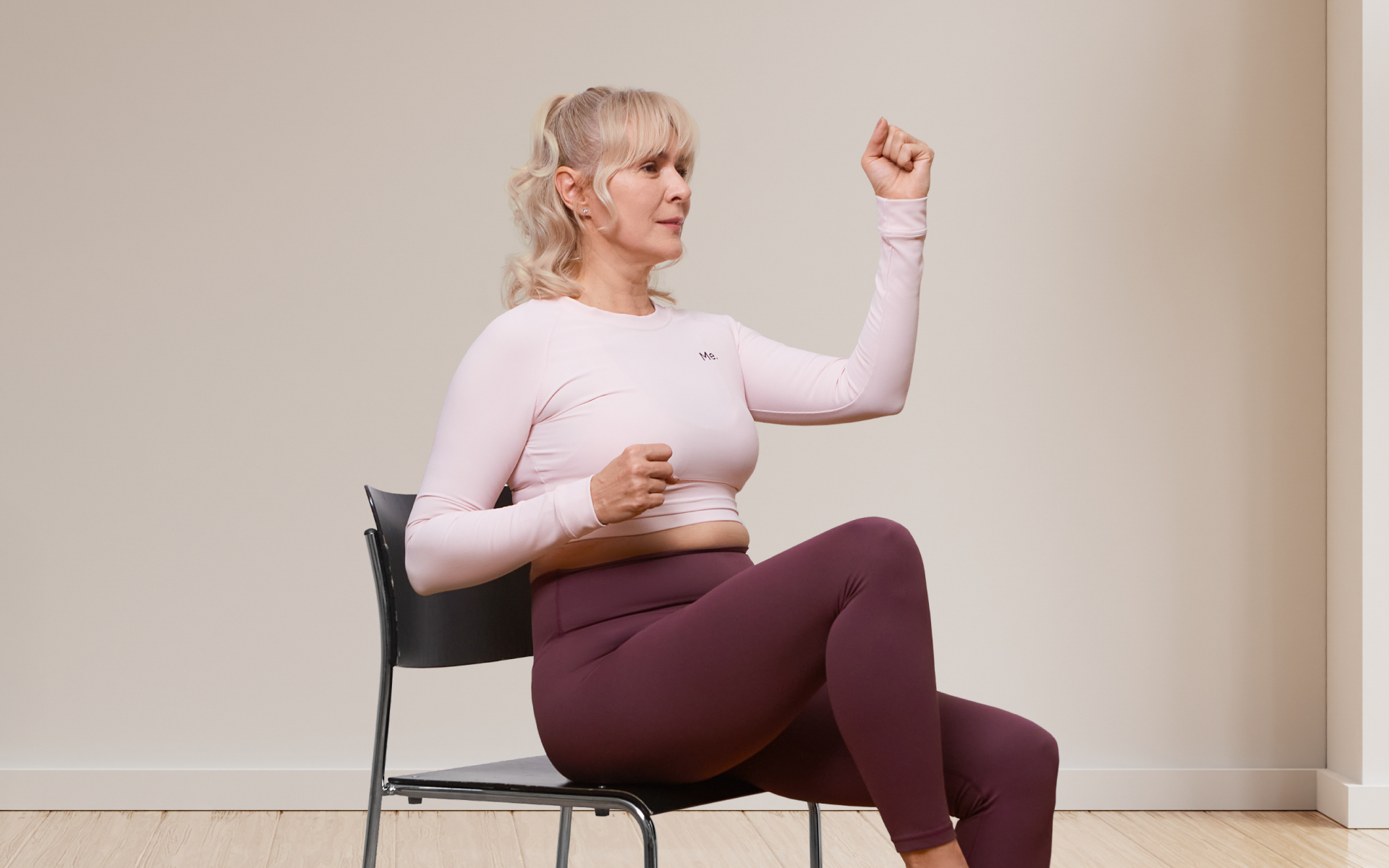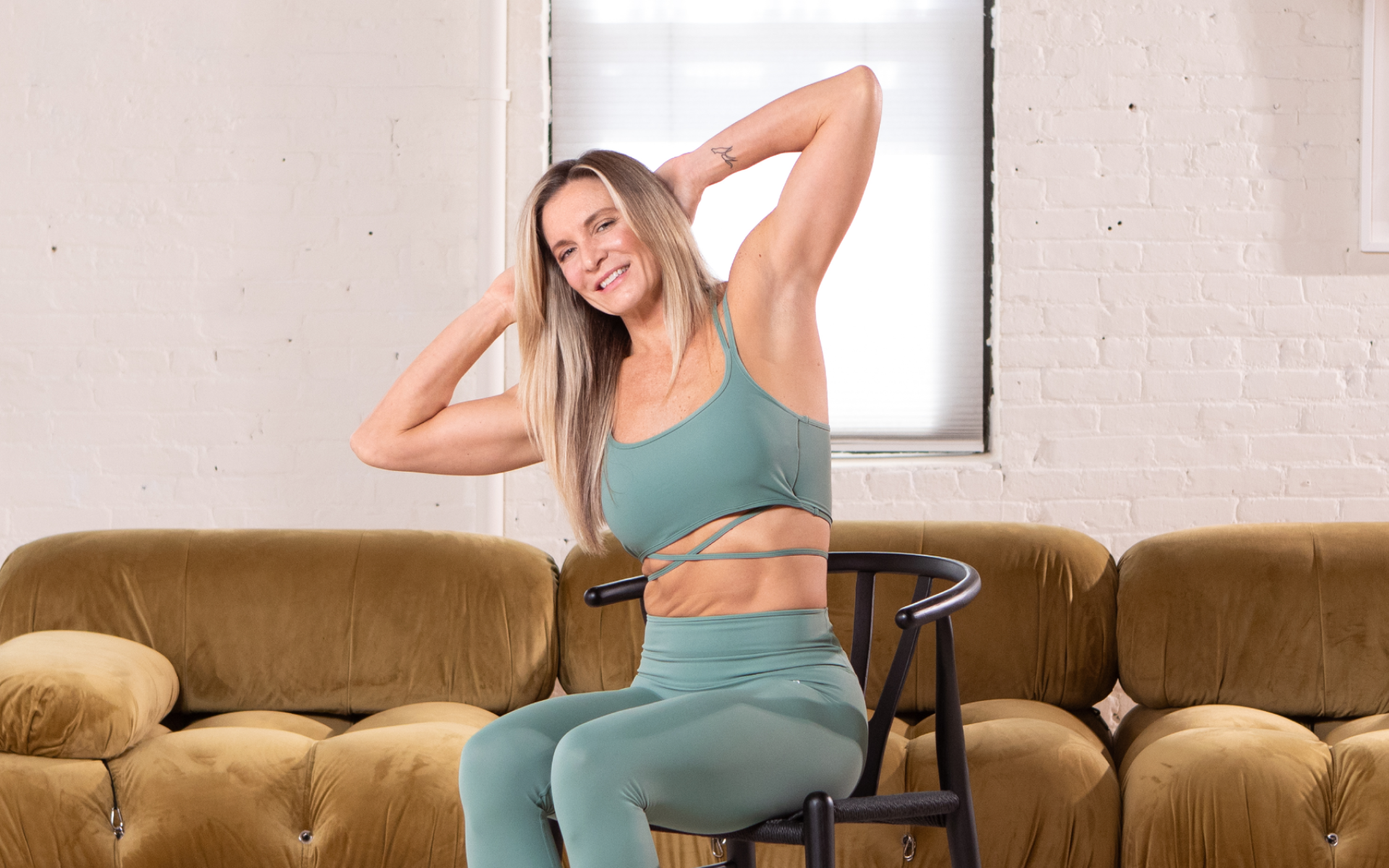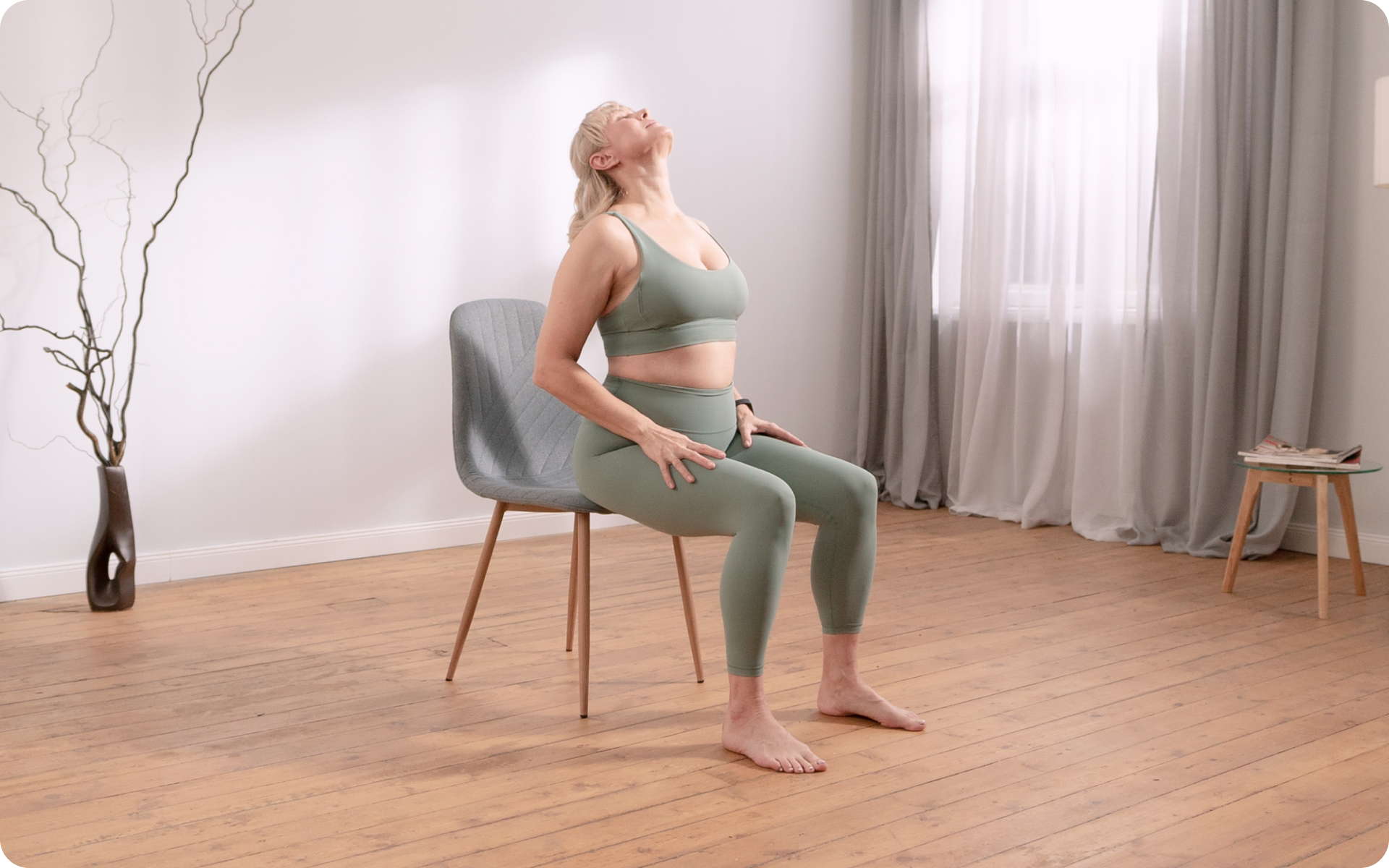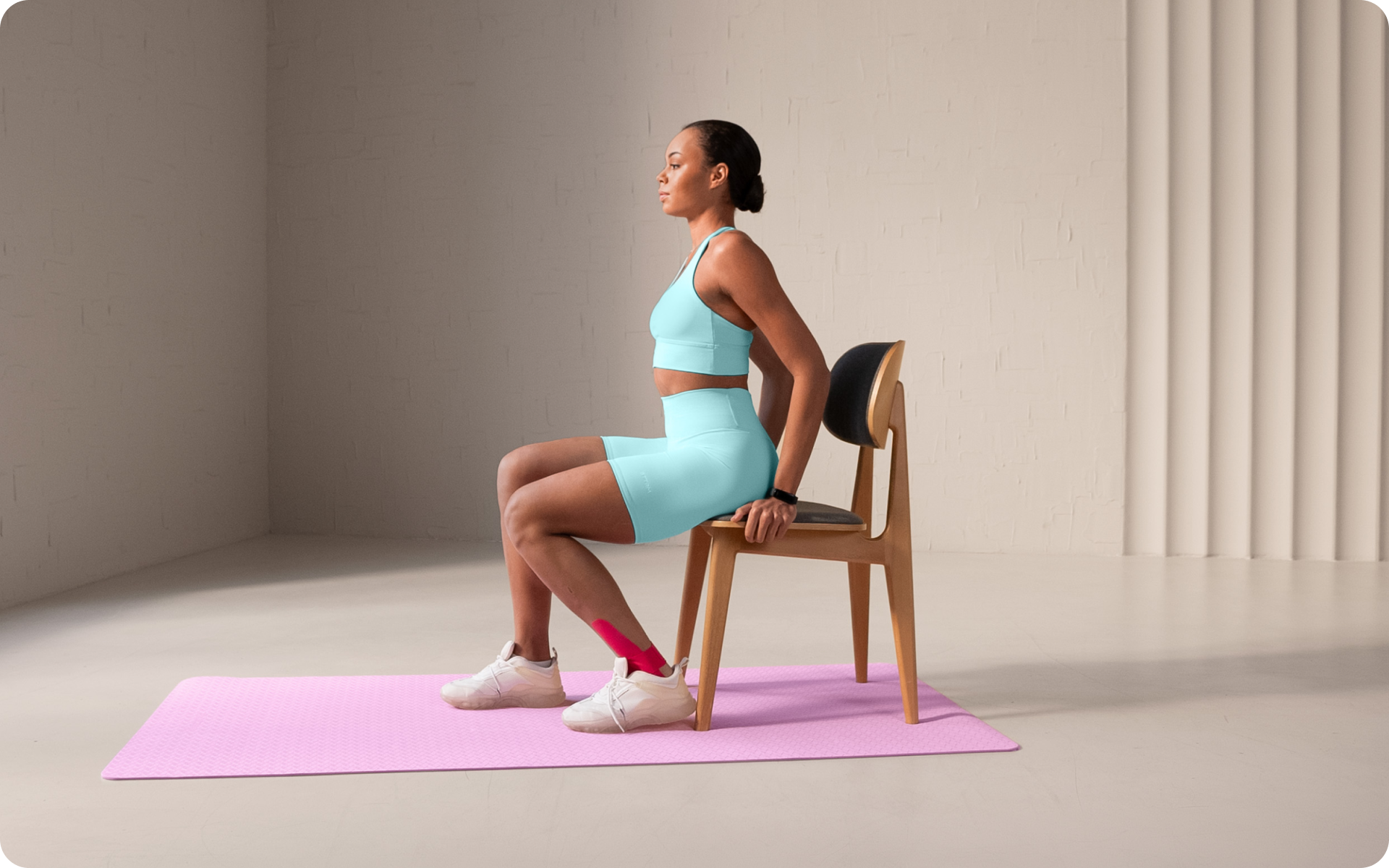Chair yoga is an ideal form of exercise for older adults who are looking for gentle yet effective ways to maintain their physical health. This modified form of traditional yoga adapts classical poses for seated practice, which makes it accessible to individuals with mobility limitations or balance concerns.
This comprehensive guide examines the science behind chair yoga for seniors, explores its safety profile, and provides 5 chair yoga exercises seniors can perform at home. The goal is to give you the necessary information to make an informed decision about incorporating this practice into your routine.
Does Chair Yoga Count as Exercise?
Chair yoga qualifies as legitimate exercise, particularly for seniors who may be limited by traditional fitness modalities.
By definition, exercise is any bodily activity that enhances or maintains physical fitness and overall health (1). For an activity to qualify as exercise, it must meet several criteria. It should:
- Increase heart rate
- Engage muscle groups
- Improve flexibility or strength
- Contribute to overall physical conditioning (2)
Chair yoga meets these criteria through multiple mechanisms. The practice engages core muscles during seated poses, activates stabilizing muscles throughout holds, and increases circulation through coordinated breathing patterns (3).
Research published in the International Journal of Scientific Research demonstrated that modified chair yoga can produce measurable improvements in older adults, including:
- Strength
- Flexibility
- Cardiovascular function (4)
The neurological benefits are equally significant. Yoga activates the parasympathetic nervous system, reducing cortisol levels and promoting recovery (5). This mind-body connection triggers neuroplasticity – the brain’s ability to form new neural pathways – which enhances both cognitive function and motor control (6).
Read more: Seated Chair Yoga for Seniors: A Complete Guide to Safe Movement
Is Chair Yoga Good for Seniors?
Chair yoga effectively addresses many physical needs of seniors, although it works best as part of a comprehensive activity program rather than as a standalone solution. For seniors with significant mobility limitations, it may serve as an excellent starting point for physical activity. Some ways it benefits seniors’ health include (4):
- Cardiovascular Health
As you age, maintaining cardiovascular health becomes increasingly important. The American Heart Association recommends at least 150 minutes of moderate-intensity aerobic activity per week for older adults (7). While it’s not traditional aerobic exercise, chair yoga can contribute to cardiovascular health through controlled breathing exercises and sustained muscular engagement.
The practice helps regulate blood pressure through deep breathing, which activates the vagus nerve and promotes heart rate variability (8). This physiological response supports long-term cardiovascular wellness, although chair yoga should complement rather than replace dedicated cardiovascular exercise.
BetterMe: Health Coaching app helps you achieve your body goals with ease and efficiency by helping to choose proper meal plans and effective workouts. Start using our app and you will see good results in a short time.
- Strength and Muscle Maintenance
Sarcopenia – age-related muscle loss – affects 10-16 % of senior adults (9). Chair yoga addresses this concern through isometric contractions and resistance-based movements. Poses such as seated warrior and chair-supported standing sequences engage major muscle groups while remaining safe for those with balance limitations.
The practice particularly benefits postural muscles, which weaken with age and contribute to forward head posture and rounded shoulders. Regular chair yoga practice can help maintain the functional strength that is needed for daily activities (10).
- Flexibility and Range of Motion
Joint stiffness increases with age due to changes in cartilage and connective tissue. Chair yoga provides gentle, controlled stretching that can help maintain and improve range of motion without placing excessive stress on joints (11).
The seated position allows for safe spinal movement, including gentle twists and side bends that maintain spinal mobility. This is particularly beneficial for seniors who spend a significant amount of time in a sedentary position.
- Balance and Fall Prevention
While chair yoga doesn’t directly challenge dynamic balance like standing exercises, it improves mobility and reduces the fear of falling in older adults (12). Enhanced upper- and lower-limb strength and static balance from chair yoga practice can contribute to better overall stability (13).
The practice also helps develop body awareness and coordination, which are essential components of fall prevention strategies (14).
Learn more about chair yoga for seniors over 60 to explore modifications for different age groups.
What Makes Chair Yoga Exercises Safe for the Elderly?
Safety considerations become paramount when designing exercise programs for older adults. Chair yoga inherently addresses many common safety concerns through its structural design and movement patterns.
Stable Base Of Support. The seated position provides a stable base of support, reducing fall risk during exercise. This allows seniors to focus on movement quality and breathing without worrying about balance challenges. The chair serves as both a support and modification tool, enabling individuals to participate regardless of lower-body strength or stability issues.
Low-Intensity With Smooth Movements. Controlled movement patterns characterize chair yoga practice. Unlike high-impact activities that may stress joints or cardiovascular systems, chair yoga emphasizes slow, deliberate movements synchronized with breathing. This approach allows practitioners to monitor their body’s response and adjust intensity accordingly.
Spine Friendly. The practice avoids loaded spinal flexion – forward bending under weight – which can be problematic for individuals with osteoporosis (15). Traditional yoga’s standing forward folds are modified to seated variations that maintain spinal safety while providing similar benefits.
Joint Friendly. Joint-friendly modifications make chair yoga accessible to individuals with arthritis or joint replacements. Range of motion can be adjusted to accommodate individual limitations, and the seated position reduces weight-bearing stress on the hip and knee joints.
Uses Breathwork For Relaxation. The emphasis on breathwork provides built-in intensity regulation. Deep, controlled breathing activates the parasympathetic nervous system, which helps prevent overexertion and promotes relaxation throughout the practice (16).
These safety features make chair yoga particularly appropriate for seniors who may have contraindications to other forms of exercise, providing a pathway to physical activity that minimizes risk while maximizing benefit.
Read more: Chair Yoga for Seniors: Simple Moves to Feel Flexible and Energized
What Are the Most Effective Chair Yoga Exercises for Seniors?
Below are 5 ideal chair yoga poses for seniors at home:
Seated Mountain Pose with Breath Awareness
This foundational pose establishes proper posture and introduces breathwork fundamentals. It addresses forward head posture and rounded shoulders while training diaphragmatic breathing patterns.
The pose activates deep stabilizing muscles of the core and spine, which improves postural endurance. The breathing component stimulates the vagus nerve, promoting relaxation and stress reduction.
Steps to perform:
- Sit tall at the front edge of your chair with your feet flat on the floor.
- Align your ears over your shoulders and your shoulders over your hips.
- Rest your hands on your thighs with your palms facing up.
- Inhale slowly for 4 counts, expanding your ribcage and belly.
- Exhale for 6 counts, gently drawing your navel toward your spine.
- Continue for 8-10 breath cycles, maintaining a tall spine throughout.
Seated Cat-Cow Stretches
This dynamic movement addresses spinal mobility, which decreases significantly with age. The exercise safely moves the spine through flexion and extension while strengthening postural muscles.
The rhythmic movement helps lubricate spinal joints and can alleviate stiffness associated with prolonged sitting. It also teaches spinal segmentation – the ability to move individual vertebrae – which improves overall spinal health.
Steps to perform:
- Sit with your hands placed on your thighs.
- Inhale, lift your chest, and gently arch your back (cow position).
- Draw your shoulder blades together and lengthen through the crown of your head.
- Exhale, round your spine, and tuck your chin toward your chest (cat position).
- Pull your belly button toward your spine and feel the stretch between your shoulder blades.
- Continue flowing between positions for 6-8 repetitions.
- Move slowly and coordinate movement with breath.
Chair-Supported Warrior II
This pose builds lower-body strength while improving hip mobility and core stability. It’s particularly beneficial for maintaining the necessary functional strength for activities such as standing from a chair or climbing stairs.
The pose engages the quadriceps, glutes, and hip stabilizers while challenging the core muscles to maintain upright posture. The arm position also strengthens the shoulders and upper back.
Steps to perform:
- Sit sideways on your chair with your right hip against the chair back.
- Extend your left leg out to the side, keeping your foot flat on the floor.
- Your right knee should be bent at 90 degrees with your thigh parallel to the floor.
- Extend your arms parallel to the floor, right arm forward, left arm back.
- Keep your torso upright and gaze over your right fingertips.
- Hold for 5-8 breaths, feeling strength in your legs and core.
- Switch sides and repeat.
Seated Spinal Twist with Arm Support
Spinal rotation becomes limited with age, and this contributes to stiffness and reduced functional mobility. This gentle twist maintains rotational capacity while remaining safe for those with osteoporosis concerns.
The supported position allows for controlled rotation without loading the spine excessively. The movement helps maintain the health of spinal discs and can alleviate tension in the back muscles.
Steps to perform:
- Sit tall with both feet flat on the floor.
- Place your right hand on the back of your chair.
- Rest your left hand on your right thigh.
- Inhale to lengthen your spine.
- Exhale and gently rotate your torso to the right.
- Keep both hips facing forward and rotate from your middle back.
- Hold for 5 breaths, feeling a gentle stretch along your spine.
- Return to center slowly and repeat on the opposite side.
Chair-Assisted Standing Sequence
This functional exercise bridges the gap between seated exercise and real-world activities. It builds the strength and coordination that are needed for safe transfers while providing a gentle challenge to the cardiovascular system.
The exercise trains the sit-to-stand movement pattern, which is essential for independence in daily activities. It engages the entire kinetic chain from feet to head, promoting functional integration.
Steps to perform:
- Sit at the front edge of your chair with your feet hip-width apart.
- Cross your arms over your chest or hold them at your sides.
- Lean slightly forward and engage your core muscles.
- Press through your heels and stand up slowly, using your leg strength.
- Pause briefly in a standing position, maintaining good posture.
- Lower back down with control, barely touching the chair before standing again.
- Repeat 5-8 times, focusing on smooth, controlled movement.
- Use your hands for assistance only if needed for safety.
Reasons why BetterMe is a safe bet: a wide range of calorie-blasting workouts, finger-licking recipes, 24/7 support, challenges that’ll keep you on your best game, and that just scratches the surface! Start using our app and watch the magic happen.
For additional modifications and variations, explore our guide to chair yoga moves for seniors to customize these exercises for your specific needs.
How Does Chair Yoga Improve Senior Mobility?
Mobility encompasses the complex interaction between strength, flexibility, balance, and coordination. Chair yoga addresses each of these components through specific mechanisms that translate to improved functional movement.
Improved Range of Motion: Chair yoga systematically moves joints through their available range of motion, which helps maintain and gradually improve flexibility (17, 18). The gentle, sustained stretches help lengthen tight muscles and mobilize stiff joints without causing tissue damage or excessive stress.
Enhanced Muscle Activation Patterns: Regular practice improves neuromuscular coordination – the communication between the nervous system and muscles. This enhanced coordination translates to smoother, more efficient movement patterns in daily activities.
Strengthened Postural Muscles: The sustained holds in chair yoga poses activate deep stabilizing muscles that support proper posture. Stronger postural muscles reduce fatigue during daily activities and help prevent the forward-hunched posture that is common in aging.
Increased Body Awareness: Yoga cultivates proprioception – the body’s sense of its position in space (19). This enhanced awareness helps seniors move more confidently and react more quickly to prevent falls or injuries.
Improved Circulation: The combination of movement and deep breathing promotes blood flow throughout the body (20). Better circulation helps deliver nutrients to tissues and remove metabolic waste, supporting overall tissue health and mobility.
Reduced Pain and Stiffness: Regular practice can help alleviate chronic pain conditions common in seniors, such as arthritis or general stiffness (17). Reduced pain naturally leads to an increased willingness to move and participate in activities.
These mobility improvements often compound over time, which creates a positive cycle where increased movement leads to better function, encouraging more activity and further improvements.
The chair yoga elderly community often reports significant improvements in their ability to perform daily tasks after consistent practice, demonstrating the real-world impact of these mobility gains.
Chair yoga and walking serve different but complementary purposes in a senior fitness program. Walking primarily provides cardiovascular benefits and weight-bearing exercise that supports bone health (21, 22), while chair yoga focuses more on flexibility, core strength, and mind-body awareness (3). For cardiovascular health, walking typically provides greater benefits due to its continuous, rhythmic nature and higher energy expenditure (23). However, chair yoga offers advantages walking cannot provide, including mobility, core strengthening, and stress reduction through breathwork (4). The ideal approach combines both activities. Walking addresses cardiovascular fitness and bone health (24), while chair yoga maintains flexibility and provides gentle strength training (3). For seniors with mobility limitations that prevent walking, chair yoga becomes more valuable as it provides accessible physical activity options. Daily chair yoga practice is generally safe and beneficial for most seniors. The gentle nature of the exercises and low impact on joints make it suitable for frequent practice. Daily practice can actually accelerate improvements in flexibility, strength, and overall well-being. However, you should listen to your body and adjust the frequency based on how you feel. Some seniors may benefit from rest days, particularly when they first start doing chair yoga. If you experience any discomfort or fatigue, consider alternating between gentler and more active sessions or incorporating complete rest days. The key is consistency rather than intensity. A shorter daily practice often provides better results than longer, infrequent sessions. Both chair Pilates and chair yoga offer benefits for seniors, but they emphasize different aspects of fitness. Chair Pilates typically focuses more on core strengthening and precise movement patterns, while chair yoga emphasizes flexibility, breathwork, and mind-body connection. Chair Pilates may be better for seniors who are looking to build core strength and improve movement precision. The exercises often involve more dynamic movements and resistance-based activities. Chair yoga may be preferable for seniors interested in stress reduction, improved flexibility, and gentle strengthening. The emphasis on breathing and mindfulness provides additional mental health benefits. Many seniors benefit from incorporating elements of both practices into their routine, as they complement each other well. Chair-supported squats are modified versions of traditional squats that use a chair for safety and assistance. These functional exercises help maintain the leg strength that is needed for standing, sitting, and stair climbing. The basic chair squat involves sitting down and standing up from a chair with control, focusing on proper form and muscle engagement. Advanced variations may include hovering above the chair seat without fully sitting or adding arm movements. Chair squats are particularly valuable as they directly train the movement pattern used in daily activities. They strengthen the quadriceps, glutes, and core muscles while improving the coordination needed for safe transfers. These exercises can be progressed by reducing hand support, increasing repetitions, or adding brief holds in the standing position.Frequently Asked Questions
Is chair yoga as good as walking?
Is it okay to do chair yoga every day?
Is chair Pilates or chair yoga better for seniors?
What are squats in chair yoga for seniors?
The Bottom Line
Chair yoga offers a scientifically-supported approach to maintaining physical health and mobility for seniors. The practice addresses key aspects of aging-related fitness concerns while remaining accessible and safe for various ability levels.
The evidence clearly demonstrates that chair yoga qualifies as legitimate exercise, providing measurable benefits for cardiovascular health, strength, flexibility, and mental well-being. Its safety profile makes it particularly appropriate for older adults who may have contraindications to other forms of exercise.
The five exercises outlined in this guide provide a foundation for beginning your chair yoga practice at home. Start with shorter sessions and gradually increase duration as your body adapts.
Consider chair yoga as one component of a comprehensive approach to healthy aging. Combine it with other appropriate activities such as walking, balance training, and social engagement for optimal results. Always consult your healthcare provider before you start any new exercise program, particularly if you have any existing health conditions or concerns.
DISCLAIMER:
This article is intended for general informational purposes only and does not serve to address individual circumstances. It is not a substitute for professional advice or help and should not be relied on for making any kind of decision-making. Any action taken as a direct or indirect result of the information in this article is entirely at your own risk and is your sole responsibility.
BetterMe, its content staff, and its medical advisors accept no responsibility for inaccuracies, errors, misstatements, inconsistencies, or omissions and specifically disclaim any liability, loss or risk, personal, professional or otherwise, which may be incurred as a consequence, directly or indirectly, of the use and/or application of any content.
You should always seek the advice of your physician or other qualified health provider with any questions you may have regarding a medical condition or your specific situation. Never disregard professional medical advice or delay seeking it because of BetterMe content. If you suspect or think you may have a medical emergency, call your doctor.
SOURCES:
- Exercise (n.d., link.springer.com)
- Physical Fitness and Its Components (n.d., physio-pedia.com)
- How to Do Chair Yoga (2024, webmd.com)
- The Effectiveness of Chair Yoga in Older Adults: A Literature Review (2023, researchgate.net)
- Neurobiological and anti-aging benefits of yoga: A comprehensive review of recent advances in non-pharmacological therapy (2024, sciencedirect.com)
- Neuroprotective effects of yoga practice: age-, experience-, and frequency-dependent plasticity (2015, pmc.ncbi.nlm.nih.gov)
- Be More Active During Your Work Day (2024, heart.org)
- Fifteen Minutes of Chair-Based Yoga Postures or Guided Meditation Performed in the Office Can Elicit a Relaxation Response (2012, ncbi.nlm.nih.gov)
- Epidemiology of sarcopenia: Prevalence, risk factors, and consequences (2023, sciencedirect.com)
- Effectiveness of Chair Yoga for Improving the Functional Fitness and Well-being of Female Community-Dwelling Older Adults With Low Physical Activities (2019, journals.lww.com)
- Aging and Synovial Joint Function: Changes in Structure and Implications for Mobility (2024, intechopen.com)
- Safety and feasibility of modified chair-yoga on functional outcome among elderly at risk for falls (2012, pmc.ncbi.nlm.nih.gov)
- Effectiveness of Chair Yoga for Improving the Functional Fitness and Well-being of Female Community-Dwelling Older Adults With Low Physical Activities (2019, journals.lww.com)
- Exploring the therapeutic effects of yoga and its ability to increase quality of life (2011, pmc.ncbi.nlm.nih.gov)
- Yoga spinal flexion positions and vertebral compression fracture in osteopenia or osteoporosis of spine: case series (2013, pubmed.ncbi.nlm.nih.gov)
- Brief structured respiration practices enhance mood and reduce physiological arousal (2023, sciencedirect.com)
- Effect of Chair Yoga Therapy on Functional Fitness and Daily Life Activities among Older Female Adults with Knee Osteoarthritis in Taiwan: A Quasi-Experimental Study (2023, pmc.ncbi.nlm.nih.gov)
- Flexibility Training and Functional Ability in Older Adults: A Systematic Review (2012, pmc.ncbi.nlm.nih.gov)
- Yoga for proprioception: A systematic review (2023, journals.lww.com)
- Enhancing Cardiovascular Health: The Positive Impact of Yoga on Blood Flow and Circulation (2024, researchgate.net)
- The multifaceted benefits of walking for healthy aging: from Blue Zones to molecular mechanisms (2023, link.springer.com)
- Walking more, not faster, is associated with bone health in China of community-dwelling older women:A cross-sectional study (2023, sciencedirect.com)
- The effect of walking on risk factors for cardiovascular disease: An updated systematic review and meta-analysis of randomised control trials (2015, sciencedirect.com)
- Walking for fitness: is it enough to maintain both heart and bone health? (2011, pubmed.ncbi.nlm.nih.gov)
